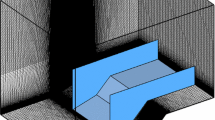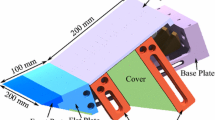Abstract
An implicit large eddy simulation, implemented using a fifth-order, bandwidth-optimized weighted essentially non-oscillatory scheme, was used to study the flow past a compression ramp at Mach 2.5 and \(\text {Re}_{\theta } = 5760\) with and without a micro-ramp vortex generator (MVG) upstream. The MVG serves as a passive flow control device. The results suggested that MVGs may distinctly reduce the separation zone at the ramp corner and lower the boundary layer shape factor. New findings regarding the MVG-ramp interacting flow included the surface pressure distribution, three-dimensional structures of the re-compression shock waves, surface separation topology, and a new secondary vortex system. The formation of the momentum deficit was studied in depth. A new mechanism was observed wherein a series of vortex rings originated from the MVG-generated high shear at the boundary of the momentum deficit zone. Vortex rings strongly interact with the shock-separated flow and play an important role in the separation zone reduction.




















Similar content being viewed by others
Abbreviations
- M :
-
Mach number
- \(\text {Re}_{\theta }\) :
-
Reynolds number based on momentum thickness
- c :
-
Micro-ramp vortex generator side length
- h :
-
MVG height
- \(\alpha \) :
-
MVG half angle
- \(\beta \) :
-
MVG declining angle of the trailing edge
- \(\delta \) :
-
Incompressible boundary-layer nominal thickness
- \(\delta ^{*}\) :
-
Incompressible boundary-layer displacement thickness
- \(\theta \) :
-
Incompressible boundary-layer momentum thickness
- \(H_{\mathrm{i}}\) :
-
Incompressible boundary-layer shape factor \(\delta ^{*}/\theta \)
- x, y, z :
-
Spanwise, normal and streamwise coordinate axes
- u, v, w :
-
Spanwise, normal and streamwise velocities
- \(p_{0}\) :
-
Pitot pressure
- \(C_{\mathrm{Ptot}_{\mathrm{rc}} }\) :
-
Pitot pressure recovery coefficient
- Pr:
-
Prandtl number
- RANS:
-
Reynolds-averaged Navier–Stokes
- LES:
-
Large eddy simulation
- DNS:
-
Direct numerical simulation
- WENO:
-
Weighted essentially non-oscillatory scheme
- TVB:
-
Total variation bounded
- SBLI:
-
Shock wave boundary layer interaction
- VG:
-
Vortex generator
- MVG:
-
Micro-ramp VG
- SWBLI:
-
Shock-wave boundary layer interaction
- w:
-
Wall
- \(\infty \) :
-
Free stream
- 0:
-
Representing the location at the inlet if without special explanation
References
Lin, J.C.: Review of research on low-profile vortex generators to control boundary-layer separation. Prog. Aerosp. Sci. 38(4–5), 389–420 (2002)
Ashill, P.R., Fulker, J.L., Hackett, K.C.: A review of recent developments in flow control. Aeronaut. J. 109(1095), 205–232 (2005)
Anderson, B.H., Tinapple, J., Surber, L.: Optimal control of shock wave turbulent boundary layer interaction using micro-array actuation. AIAA paper 2006–3197 (2006)
Lu, F., Li, Q., Liu, C.: Micro vortex generators in high-speed flow. Prog. Aerosp. Sci. 53, 30–45 (2012)
Holden, H.A., Babinsky, H.: Vortex generators near shock/boundary layer interactions. AIAA paper 2004-1242 (2004)
Babinsky, H., Makinson, N.J., Morgan, C.E.: Micro-vortex generator flow control for supersonic engine inlets. AIAA paper 2007-521 (2007)
Holden, H., Babinsky, H.: Effect of microvortex generators on separated normal shock/boundary layer interactions. J. Aircraft 44(1), 170–173 (2007)
Babinsky, H., Li, Y., Ford, C.W.P.: Microramp control of supersonic oblique shock-wave/boundary-layer interactions. AIAA J. 47(3), 668–675 (2009)
Saad, M.R., Zare-Behtash, H., Che-Idris, A., Kontis, K.: Micro-ramps for hypersonic flow control. Micromachines 3(2), 364–378 (2012)
Estruch-Samper, D., Vanstone, L., Hillier, R., Ganapathisubramani, B.: Micro vortex generator control of axisymmetric high-speed laminar boundary layer separation. Shock Waves 25(5), 521–533 (2015)
Ghosh, S., Choi J., Edwards, J. R.: RANS and hybrid LES/RANS simulations of the effects of micro vortex generators using immersed boundary methods. AIAA paper 2008-3728 (2008)
Lee, S., Loth E., Wang, C., Kim, S.: LES of supersonic turbulent boundary layers with \(\mu \)VG’s. AIAA Paper 2007-3916 (2007)
Lee, S., Loth, E.: Supersonic boundary layer interactions with various micro-vortex generator geometries. AIAA paper 2009-3712 (2009)
John, B., Emerson, D.R., Gu, X.J.: Parallel Navier–Stokes simulations for high speed compressible flow past arbitrary geometries using FLASH. Comput. Fluids 110(30), 27–35 (2015)
John, B., Emerson, D.R., Gu, X.J.: Parallel compressilbe viscous flow simulations using FLASH code: implementation for arbitrary 3D geometries. Procedia Eng. 61, 52–56 (2013)
Zhang, B., Zhao, Q., Xiang, X., Xu, J.: An improved micro-vortex generator in supersonic flows. Aerosp. Sci. Technol. 47, 210–215 (2015)
Dolling, D.S., Murthy, M.T.: Unsteadiness of the separation shock wave structure in a supersonic compression ramp flowfield. AIAA J. 21(12), 1628–1634 (1983)
Dolling, D.S.: High-speed turbulent separated flows: consistency of mathematic models and flow physics. AIAA J. 36(5), 725–732 (1998)
Dolling, D.S.: Fifty years of shock-wave/boundary-layer interaction research: what next? AIAA J. 39(8), 1517–1531 (2001)
Settles, G.S., Dodson, L.J.: Supersonic and hypersonic shock/boundary layer interaction database. AIAA J. 32(7), 1377–1383 (1994)
Dussauge, J.P., Dupont, P., Debieve, J.F.: Unsteadiness in shock wave boundary layer interaction with separation. Aerosp. Sci. Technol. 10(2), 85–91 (2006)
Andreopoulos, Y., Agui, J.H., Briassulis, G.: Shock wave–turbulence interactions. Annu. Rev. Fluid Mech. 32, 309–345 (2000)
Loginov, M.S., Adams, N.A., Zheltovodov, A.A.: Large-eddy simulation of shock-wave/turbulent-boundary-layer interaction. J. Fluid Mech. 565, 135–169 (2006)
Wilcox, D.: Turbulence Modeling for CFD. DCW Industries Inc, La Cãnada, CA (1993)
Zheltovodov, A.A.: Advances and problems in modeling of shock wave turbulent boundary layer interactions. In: Proceedings of the International Conference on the Methods of Aerophysical Research, pp. 149–157. Institute of Theoretical and Applied Mechanics, Novosibirsk (2004)
Rizzetta, D., Visbal, M., Datta, V.G.: Large eddy simulation of supersonic compression-ramp flow by high-order method. AIAA J. 39(12), 2283–2292 (2001)
Kaenel, R.V., Kleiser, L., Adams, N.A., Vos, J.B.: Large-eddy simulation of shock–turbulence interaction. AIAA J. 42(12), 2516–2528 (2004)
Adams, N.A.: Direct simulation of the turbulent boundary layer along a compression ramp at \(M = 3\) and \(Re_{\theta }=1685\). J. Fluid Mech. 420, 47–83 (2000)
Wu, M., Martin, M.P.: Direct numerical simulation of supersonic turbulent boundary layer over a compression ramp. AIAA J. 45(4), 879–889 (2007)
Martín, M.P.: Direct numerical simulation of hypersonic turbulent boundary layers. Part 1. Initialization and comparison with experiments. J. Fluid Mech. 570, 347–364 (2007)
Ringuette, M., Wu, M., Martín, M.P.: Low Reynolds number effects in a Mach 3 shock/turbulent-boundary-layer interaction. AIAA J. 46(7), 1883–1886 (2008)
Wu, M., Martín, M.P.: Analysis of shock motion in shockwave and turbulent boundary layer interaction using direct numerical simulation data. J. Fluid Mech. 594, 71–83 (2008)
Ringuette, M.J., Wu, M., Martín, M.P.: Coherent structures in direct numerical simulation of turbulent boundary layers at Mach 3. J. Fluid Mech. 594, 59–69 (2008)
Priebe, S., Wu, M., Martín, M.P.: Direct numerical simulation of a reflected-shock-wave/turbulent-boundary-layer interaction. AIAA J. 47(5), 1173–1185 (2009)
Bookey, P., Wyckham, C., Smits, A.J.: Experimental investigations of Mach 3 shock-wave turbulent boundary layer interactions. AIAA paper 2005-4899 (2005)
Cattafesta III, L.N., Sheplak, M.: Actuators for active flow control. Annu. Rev. Fluid Mech. 43, 247–272 (2011)
Blinde, P.L., Humble, R.A., Van Oudheusden, B.W., Scarano, F.: Effects of micro-ramps on a shock wave/turbulent boundary layer interaction. Shock Waves 19(6), 507–520 (2009)
Sun, Z., Schrijer, F.F.J., Scarano, F., Van Oudheusden, B.W.: The three dimensional flow organization past a micro-ramp in a supersonic boundary layer. Phys. Fluids 24(5), 055105-055105-22 (2012)
König, B., Pätzold, M., Lutz, T., Krämer, E., Rosemann, H., Richter, K., Uhlemann, H.: Numerical and experimental validation of three dimensional shock control bumps. J. Aircraft 46(2), 675–682 (2009)
Marxen, O., Rist, U.: Mean flow deformation in a laminar separation bubble: separation and stability characteristics. J. Fluid Mech. 660, 37–54 (2010)
Smits, A.J., Dussauge, J.P.: Turbulent Shear Layers in Supersonic Flow, 2nd edn. Springer, New York (2006)
Boris, J.P., Grinstein, F.F., Oran, E.S., Kolbe, R.L.: New insights into large eddy simulation. J. Fluid Dyn. Res. 10, 199–228 (1992)
Fureby, C., Grinstein, F.F.: Monotonically integrated large eddy simulation of free shear flows. AIAA J. 37(5), 544–556 (1999)
Fureby, C., Alin, N., Wikstrom, N., Menon, S., Svanstedt, N., Persson, L.: Large eddy simulation of high-Reynolds-number and wall-bounded flows. AIAA J. 42(3), 457–468 (2004)
Grinstein, F.F., Margolin, L.G., Rider, W.J.: Implicit Large Eddy Simulation. Cambridge University Press, Cambridge (2007)
Visbal, M.R., Morgan, P.E., Rizzetta, D.P.: An implicit LES approach based on high-order compact differencing and filtering scheme. AIAA paper 2003-4098 (2003)
Morgan, P.E., Rizzetta, D.P., Visbal, M.R.: Large-eddy simulation of separation control for flow over a wall-mounted hump. AIAA J. 45(11), 2643–2660 (2007)
Rizzetta, D.P., Visbal, M.R., Gaitonde, D.V.: Large-eddy simulation of the supersonic compression-ramp flow by high-order method. AIAA J. 39(12), 2283–2292 (2001)
Rizzetta, D.P., Visbal, M.R.: Application of large-eddy simulation to supersonic compression ramps. AIAA J. 40(8), 1574–1581 (2002)
Garnier, E., Mossi, M., Sagaut, P., Comte, P., Deville, M.: On the use of shock-capturing schemes for large-eddy simulation. J. Comput. Phys. 153(2), 273–311 (1999)
Ladeinde, F., Cai, X., Visbal, M.R., Gaitonde, D.V.: Turbulent spectra characteristics of high order schemes for direct and large eddy simulation. Appl. Numer. Math. 36(4), 447–474 (2001)
Gao, R., Yu, J., Kong, W., Yan, C.: Evaluation of a WENO method in implicit large eddy simulation of circular cylinder flow. In: The 2nd International Conference on Computer and Automation Engineering (ICCAE), Singapore, vol. 5, pp. 308 - 312 (2010)
Weirs, V.G., Candler, G.V.: Optimization of weighted ENO schemes for DNS of compressible turbulence. AIAA paper 97-1940 (1997)
Cockburn, B., Shu, C.W.: TVB Runge-Kutta local projection discontnuous Galerkin finite element method for conservation laws II: general framework. Math. Comput. 52(186), 411–435 (1989)
Li, Q., Liu, C.: Numerical investigations on the effects of the declining angle of the trailing-edge of MVG. AIAA paper 2010-714 (2010)
Li, Q., Liu, C.: LES for supersonic ramp control flow using MVG at \(M=2.5\) and \({Re}_{\theta }=1440\). AIAA paper 2010-592 (2010)
Liu, C., Chen, L.: Study of mechanism of ring-like vortex formation in late flow transition. AIAA paper 2010-1456 (2010)
Rusanov, V.V.: A blunt body in a supersonic stream. Annu. Rev. Fluid Mech. 8, 377–404 (1976)
Titchener, N., Babinsky, H.: A review of the use of vortex generators for mitigating shock-induced separation. Shock Waves 25(5), 473–494 (2015)
Guarini, S.E., Moser, R.D., Shariff, K., Wray, A.: Direct numerical simulation of a supersonic turbulent boundary layer at Mach 2.5. J. Fluid Mech. 414(1), 1–33 (2000)
Dong, Y., Yan, Y., Liu, C.: New visualization method for vortex structure in turbulence by lambda2 and vortex filaments. Appl. Math. Model. 40, 500–509 (2016)
Yan, Y., Li, Q., Liu, C., Pierce, A., Lu, F., Lu, P.: Numerical discovery and experimental confirmation of vortex ring generation by microramp vortex generator. Appl. Math. Model. 36(11), 5700–5708 (2012)
Li, Q., Yan, Y., Lu, P., Pierce, A., Liu, C., Lu, F.: Numerical and experimental studies on the separation topology of the MVG controlled flow at \(M=2.5\). AIAA paper 2011-72 (2011)
Lu, F.K.: Visualization of supersonic flow around a sharp-edged, sub-boundary-layer protuberance. J. Vis. 18(4), 619–629 (2015)
Manisankar,C., Verma, S.B., Raju, C.: Shock-wave boundary-layer interaction control on a compression corner using mechanical vortex generators. In: Proceedings of 28th international symposium on shock waves, Manchester (2011). [Ed. by Kontis, K. Springer, New York, pp. 409-415. ISBN 978-3-642-25688-2 (2012)]
Acknowledgments
This work was supported by AFOSR Grant FA9550-08-1-0201 supervised by John Schmisseur and Opening Project of Shanghai Key Laboratory of Multiphase Flow and Heat Transfer in Power Engineering. The authors are grateful to Texas Advantage Computing Center (TACC) for providing computational hours. The authors thank Frank Lu for providing some experimental snapshots.
Author information
Authors and Affiliations
Corresponding author
Additional information
Communicated by A. Hadjadj and A. Higgins.
Rights and permissions
About this article
Cite this article
Yan, Y., Chen, L., Li, Q. et al. Numerical study of micro-ramp vortex generator for supersonic ramp flow control at Mach 2.5. Shock Waves 27, 79–96 (2017). https://doi.org/10.1007/s00193-016-0633-4
Received:
Revised:
Accepted:
Published:
Issue Date:
DOI: https://doi.org/10.1007/s00193-016-0633-4




